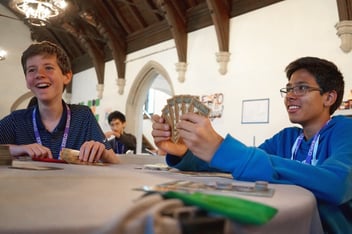Family Board Game Review: Dice Edition

At Explo, we’re big fans of playing games in general — and think board games in particular are a great tool for sharpening one’s wit, learning social graces, and having a great time along the way. In today’s edition of our Family Board Game Review, we look at some games that use dice in an interesting way.
Machi Koro
This Japanese city building game (just recently published in the United States) has taken over Explo’s Friday game club. And for good reason.
Armed with one or two die, your goal is to construct four major landmarks in your city before your opponents. To grow your city, you build an economy by purchasing various establishments (a bakery? a wheat field? a cheese factory?) that may pay you each turn, depending on who is rolling the dice, and what they roll.
In Machi Koro, the mechanics of the game are deceptively simple and extremely fast paced. Gameplay is as light and happy as the illustrations on the cards, and everyone is invested — giddily — in each player’s turn, because each roll can be a payday.
Unlike other resource management games (like Settlers of Catan), resources are quick to come by and you’re never out of funds for long. Instead, the focus of the game is figuring out how to spread your investments and string them together for maximum growth.
One of the interesting mechanic shifts in the game is the ability (once you have constructed a railroad) to choose whether to roll one die or two on your turn. At the beginning of the game — when players can only roll one die — it makes sense to invest in establishments that are activated with a die roll of 1 - 6. However, the rewards are greater for establishments activated by rolls of 7-12… though the probability of rolling those numbers changes significantly when you roll two dice.
But we’re getting ahead of ourselves. In practice, the mathematics of the game take a huge back seat to the riveting city-building narrative — you want to purchase an amusement park, don’t you? We think you’ll find Machi Koro to be a great addition to your family’s game collection. It’s definitely our favorite new game of the year.
30 minutes / 2-4 players / 7 and up
Amazon link: Machi Koro
Can’t Stop
Sid Jackson’s classic press-your-luck dice game is not only a fun, rip-roaring game of educated risk taking, but also a tangible introduction to understanding probability and relative frequency.
But don’t let that academic speak scare you: this game is FUN.

The goal is to move three of your markers to the end of the tracks on the board, which are numbered 2-12. On each turn, a player (we'll call her Sue) rolls four dice and makes two 2-dice combinations of the outcome — if the player can advance on a track corresponding to one or both of the 2-dice totals, Sue places a white “runner” marker on the track. Sue then has the opportunity to either roll again and attempt to advance further on the tracks she’s started (up to three tracks), or to stop, and lock in her advancement on each track. If she rolls again and can’t make a combination on an available track, Sue loses all of the advancement she’s accrued with her runner, and play moves to the next player.
If it sounds complicated — or even nerdy — it’s really not. It’s fast dice rolling. Quick number combinations. And the constant drama of players pressing their luck just. one. more. time.
It’s also a sneaky way to get kids comfortable with probability. Players quickly become aware that it’s far easier to continue to roll when you’re running down tracks 7, 6, and 8, than when you’re trying to roll on 2, 3, and 11. And while the game is a constant reinforcement on the mathematics of probability (the board even resembles a histogram of the combined outcome of a two-dice roll) — what your family will really take away from it is that Can't Stop is an engaging (and all-consuming!) game that will keep you playing for round after round.
30 minutes / 2-4 players / 7 and up.
Amazon link: Can't Stop Board Game
Blueprints
In the French game Blueprints, you are an architect assigned to build 3D structures out of dice. Will you earn points by following your blueprints to the “T” — or will you try to freestyle a design to win awards that might score you more?

We’ve never encountered a game quite like Blueprints, which is part abstract 3D puzzle building and part analytic strategizing. During each of three rounds, you construct a building in secret while competing against opponents from a pool of limited resources and end-of-game awards.
The resources in the game are the dice. There are four different colors of dice, and each die color scores points in different ways, depending on how they are added to your structure. And there is one more complicating factor: you can only place a die on top of one another one if the value of the die is equal to or higher than the die it is going on top of. So if you have a die with the value of “1”, you cannot put that die on top of another die with a value of “2” or higher.
What you end up with is a complex, spatial, and conceptual puzzle that is as much about solving your own structural plans as it is stopping your opponents from completing their buildings. At the end of each round, each player reveals their structure, tallies their points, and wins (or gives) awards.
30 minutes / 2-4 players / 14 and up.
Amazon link: Blueprints Board Game
Cube Quest
Described as a more strategic, table-top version of the 80’s living room classic Crossbows and Catapults — Cube Quest lives up to the billing, using plastic, hollow dice as both defensive barracks and offensive ammunition.
The object of this "battle game with dice" is to knock your opponent’s king off the playing mat. You do this, literally, by flicking your cubes at your opponent. As you might imagine, games are quick and dexterous — or as dexterous as you can be with your finger and your thumb — and generally involve a bit of organized chaos (and dice flying all over the room).

But that’s not to say that it is a game without strategy. There is strategy in how your set up your army to defend your king. Do you form a wall around your castle, or create a blanket of defenders to shoot through? And because each type of die has different attributes, there is strategy in picking which dice you flick “over the river” — if your dice land “heads up” in enemy territory, they are safe, but if they land with a “shadow side” showing, they are at risk of being captured.
You’ll quickly learn that shorter, more controlled flicks (which keep your dice on the playing field) are usually preferable, in the long run, to power flicks that tend to fire across the room, sometimes taking opponent pieces with them… sometimes not. But the joy in the game is that matches are so quick, that there is no harm in trying different strategies.
A Cube Quest battle usually takes less than 10 minutes — unless you’ve gotten quite good at flicking, and your match becomes an epic tactical one. It’s a fun game for two players, who will generally end up playing a series of battles against one another — but it’s quick enough that multiple players can take turns competing. Besides, spectators add to the ridiculousness, excitement, and fun. They can also fetch wayward cubes!
30 minutes / 2-4 players / 8 and up.
Amazon Link: Cube Quest: Clash for The Crown Board Game
Escape: The Curse of the Temple
At Explo, we love cooperative games. And Escape: The Curse of the Temple is an amazing, tension-filled, action-packed, frantic dice-rolling, cooperative adventure game played in real time that ends in ten minutes, when the cursed temple collapses — whether your team has escaped or not.
There are three major goals in the game: (1) discover the exit to the temple (by opening new rooms), (2) activate enough magical gems to open the exit (it is a cursed temple, after all), and (3) have everybody in your party escape.
The mechanics for doing this: a lot of die rolling, and a lot of coordination.

At the start of the game, each player is armed with 5 dice that have different symbols on them. By rolling different combinations of the symbols, you can take different actions: like entering a new room or activating magical gems. You can pick up and re-roll your dice as many times as you wish, unless you roll a “Cursed Mask” symbol. In that case, you must set aside the “cursed” die until a “Golden Mask” is rolled to remove the curse.
Of course, this a cooperative game, so if you are in the same room as other members of your party, you can — and often need to — pool and share your various dice rolls for the common good, whether it is to unlock a player’s “cursed” dice or to access treasure.
Adding to the tension and the real-time aspect of Escape is a mood-setting soundtrack that is played in the background. At certain points, a countdown starts, and if players aren’t back in the starting room when the countdown is over, they lose one of their dice. (You do NOT want to lose one of your dice!)
As with many cooperative games, Escape: The Curse of the Temple is a study in group dynamics and behaviors. You have to work together to succeed — particularly to succeed in just 10 minutes — and if everyone is not on the same page, the team will fail. We find that prior to the game, it’s great to strategize different roles — who will lead the search for the exit, who will be in track of the time, who will focus on activating gems — and we try to switch roles in different games, giving players practice leading and following.
There are very few games out there that will get your whole family’s blood pumping quite like Escape. It’s a ten-minute adventure that will have you sweating it out until the very end — whether you make it out alive, or not.
10 minutes / 1-5 players / 8 and up.
Amazon Link: Escape: The Curse of the Temple Board Game



